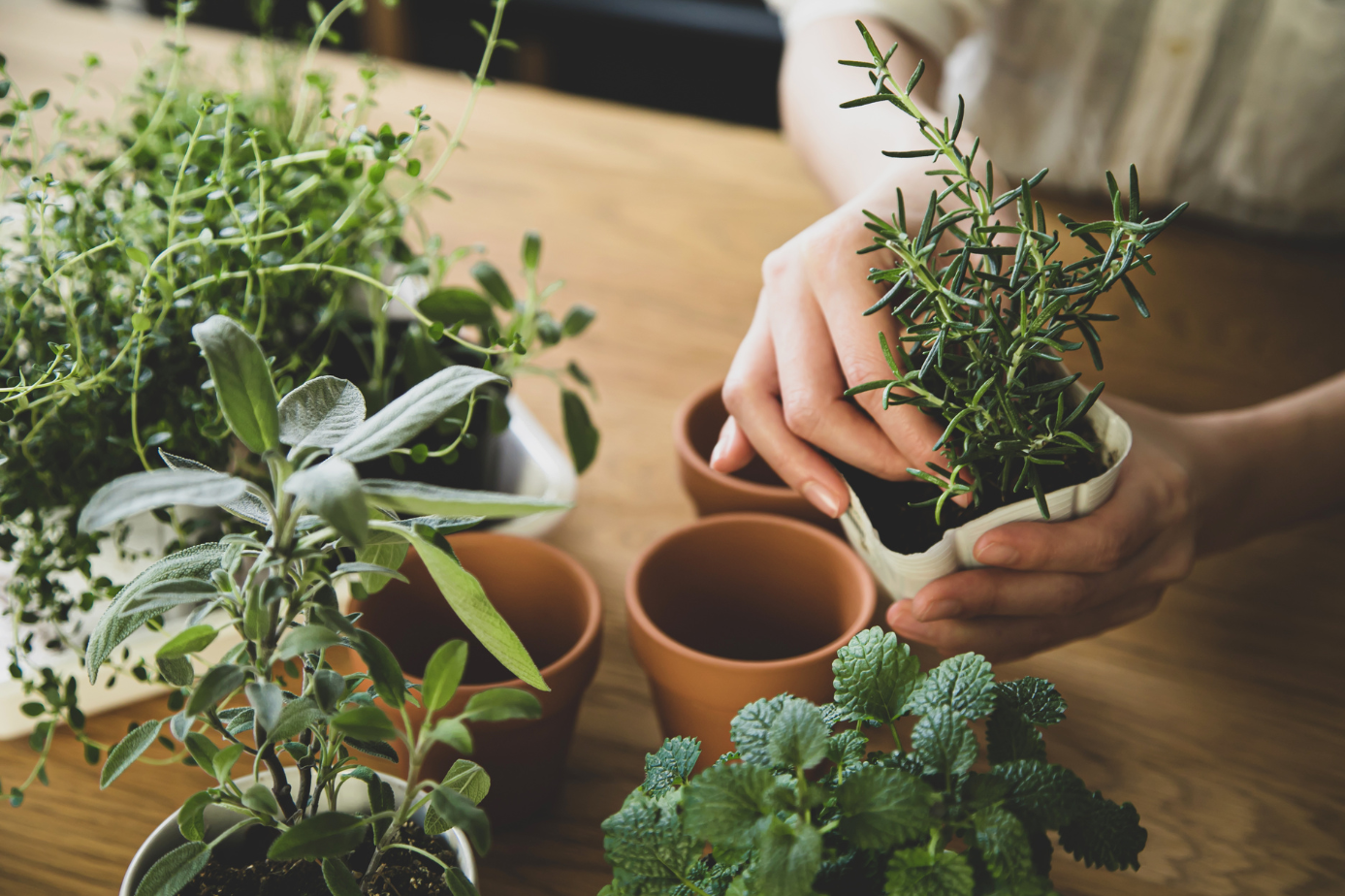.png)
Picture this: fresh herbs for your pasta, crisp lettuce for your salads, and juicy tomatoes ripening on the vine—all within arm’s reach, right inside your home. Starting an indoor food garden is a fun way to add fresh, homegrown flavor to your meals and bring a little greenery into your space while reducing your dependency on the grocery store (and those fluctuating prices!). Plus, it’s easier than you think! Here’s how to get started, even if you’ve never grown a thing in your life.
1. Choose the Right Spot
Plants need light, so the best place for your indoor garden is near a south- or west-facing window where they’ll get plenty of sun. If your home doesn’t have enough natural light, don’t worry—LED grow lights are a great alternative and can keep your plants thriving. Make sure you follow the instructions on how far to place your lights away from your plants, and adjust based on what type of plant you’ve got.
It’s also convenient (for you) and helpful (for your plants) to set your lights on a timer that mimics the natural rhythm of daylight. If you have a smart home setup, smart plugs set to turn on and off with the sunrise and sunset can be a great option. If not, many grow lights come with built in timers that you can set manually.
2. Start with the Easiest Plants
If you’re new to gardening, start with plants that grow quickly and require little fuss. Some great beginner-friendly choices include:
- Herbs: Basil, mint, parsley, and chives are low-maintenance and perfect for cooking. Keep mint in a separate pot as it tends to spread aggressively. Thyme, oregano, and rosemary also thrive indoors with minimal care.
- Leafy Greens: Lettuce, spinach, and arugula grow fast and don’t take up much space. Harvest the outer leaves first so the plant keeps producing. Swiss chard and bok choy are also excellent options for continuous harvesting.
- Microgreens: These tiny, nutrient-packed greens (like radish, kale, and mustard) grow in just a couple of weeks! Use a shallow tray with a fine layer of soil, mist them daily, and enjoy a fresh harvest in about 10-14 days.
- Tomatoes and Peppers: Small varieties like cherry tomatoes and mini bell peppers can thrive indoors with sufficient light. Use a deep container with sturdy support for best results.
- Root Vegetables: Carrots, radishes, and green onions can be successfully grown in deeper pots. Green onions can even be regrown from store-bought ones by placing their roots in water before transplanting them into soil.
- Strawberries: Ever-bearing strawberry plants can produce fruit year-round if placed in a bright location. Hanging baskets work particularly well for these.
3. Pick the Right Containers
Almost any container can work, as long as it has good drainage. If you’re reusing old pots, just make sure they have holes at the bottom. Here’s a breakdown of what works best for different plants:
- Herbs and Microgreens: Shallow containers (4-6 inches deep) work best. Herbs can be grown in individual small pots or grouped together in a larger planter. Microgreens thrive in flat trays.
- Leafy Greens: Medium-sized pots (6-8 inches deep) work well. Consider long, rectangular planters to grow multiple greens in a small space.
- Tomatoes and Peppers: Deep pots (at least 12 inches) with good drainage are necessary. Use a sturdy container and provide a trellis or stake for support as the plants grow.
- Root Vegetables: Carrots and radishes need deep pots (8-12 inches) to allow for proper root development. Green onions can grow in shallower containers (6 inches) but will thrive in deeper ones too.
- Strawberries: Hanging baskets or deep pots (6-8 inches) with good drainage holes are ideal. Make sure they have room to spread and trail over the sides.
Don’t have a lot of space? Arranging smaller pots in tiers or on shelves is a good way to make use of limited space, while hanging pots, vertical planters, and support trellises can help container gardens grow vertically.Oh—one more tip on containers. While it might seem logical to layer gravel at the bottom of the pot to assist with drainage, doing this actually prevents drainage and increases water retention in the soil. This is called perching, and it happens because water does not easily move from a fine-textured material (like soil) to a coarser material (like gravel) until the soil above becomes completely saturated. For this reason, it’s better to simply use high-quality potting soil in a pot with drainage holes.
4. Use Quality Soil and Fertilizer
Don’t just scoop up dirt from your backyard—indoor plants do best in light, well-draining potting mix. Look for organic potting soil, and give your plants a boost with a balanced liquid fertilizer every few weeks.
For leafy greens, herbs, and microgreens, you can fertilize every two to four weeks with a diluted liquid fertilizer—but you likely won’t need to due to their short growth cycle and reliance on seed nutrients.
Fruiting plants like tomatoes, peppers, and strawberries benefit from a fertilizer high in phosphorus and potassium every two weeks during flowering and fruiting stages. Not sure which one to get? Ask an expert from your local gardening store.
Root vegetables like carrots and radishes need only a light feeding once a month. This is because excessive fertilization can lead to lush foliage at the expense of root development—which is the part you want. A balanced fertilizer with moderate nitrogen levels is ideal for these plants.
Always follow the recommended dosage on the fertilizer label, and avoid applying it to dry soil. Water your plants first to prevent root burn!
5. Water Smartly
Overwatering is the number one killer of indoor plants. Water when the top inch of soil feels dry—if it’s still moist, wait a bit. A spray bottle works well for delicate seedlings, while a small watering can is great for larger plants. You can also use self-watering planters if you’re concerned about this part, and place a tray underneath pots to catch excess moisture.
6. Give Them Some TLC
Plants are living things, and like any living thing, they need care. Check in on them regularly—trim herbs to encourage growth, rotate plants so they grow evenly toward the light, and watch for any signs of pests. If you notice gnats or tiny bugs, try sprinkling cinnamon on the soil or using a mild soap spray.
7. Enjoy the Rewards!
There’s nothing quite like snipping fresh basil for your homemade pizza or picking crisp greens for a salad you grew yourself. Plus, tending to an indoor garden is a great stress reliever and a beautiful way to bring life into your home.
Starting small is the key—just a few pots on a sunny windowsill can get you hooked on growing your own food. Who knows? Today, it’s basil and lettuce. Tomorrow, you might be harvesting peppers and cherry tomatoes!
Are you thinking about starting an indoor food garden? Let me know what you’d love to grow!
Need more space for your indoor garden?
Let's find you the perfect home.


.png)



